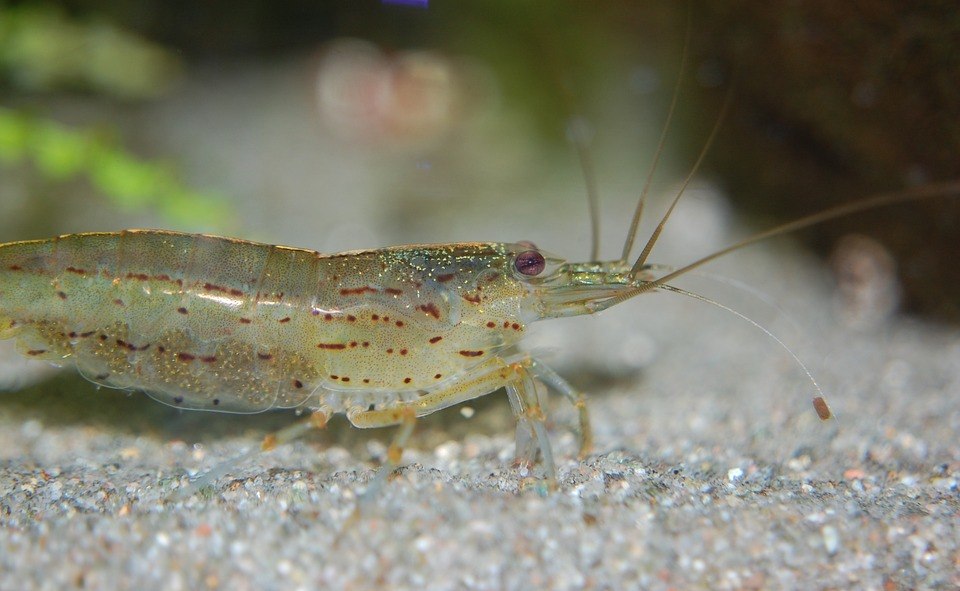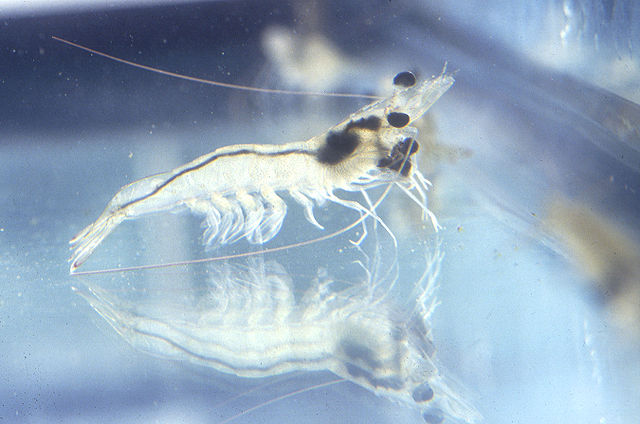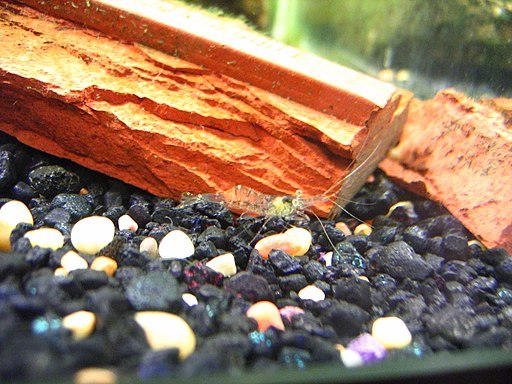Ghost shrimp are fun little invertebrates, and are sold frequently in pet stores, though they are usually used as feeder fish. So, why would you want any in your tank?
It’s not as if you’d keep a tank full of fish flakes and nothing else. These feisty little critters are more than just fish food, though—they are great cleaners, and can make a handsome addition to your tank.
Ghost shrimp care is simple and rewarding, so let’s take a look at these odd little creatures.
Contents
Ghost Shrimp Appearance
Ghost shrimp are also known as glass shrimp. In the wild, they live in brackish wetlands, and are active invertebrates.
They are bottom-feeders, and their bodies are translucent. They range in color from almost completely clear to a reddish hue, though most of them are relatively clear with a green or gray tint. You can still see their insides, which makes them all the more fascinating to watch in your tank.
They look similar to crayfish, but are smaller and have a much softer shell. These shrimp are easy to care for, too; they are scavengers and will pick up any food that your fish do not eat, helping the overall health of your tank.
Size and Pricing
These are small shrimp, and adults only get to about 1.5 inches in length, and about as big as a pencil eraser. They are relatively fragile animals, so how long do ghost shrimp live?
Well, they are best bought in batches. Usually some will die within a few days due to the change in environment, but once settled in, they usually live for about a year.
Luckily, they are a cheap addition to your tank and many stores will offer bulk discounts for them, as they are often sold as feeders for aggressive fish like cichlids.
Ghost Shrimp Personality
Ghost shrimp are strong swimmers despite their size. A few flicks of their tail can have them across the tank if they think they’re in danger, though most of the time they walk around on the substrate, scavenging for food.
They molt their shells relatively frequently as they grow. This is common and the sign of a healthy shrimp.
They are very vulnerable after they molt, so they need plenty of hiding spaces, but the other shrimp will feed off of the discarded shell to get needed nutrients back into their bodies.
Ghost Shrimp Breeding
Ghost shrimp breeding can be challenging. Did you know that when a female ghost shrimp is pregnant, she is said to be berried?
Because these shrimp are translucent, you can easily see when they’re pregnant, and it does look like the eggs are berries in her shell. They can reproduce in fresh water and can be bought pregnant in some stores.
Move berried shrimp to a separate tank so that the babies are not eaten by your other fish. Make sure that this separate tank has a fine mesh cover over the power filter, or it may suck up and kill the larvae.
If you are going to breed them as feeders, you don’t need an elaborate tank set up. Make sure they have an air stone to keep the water moving and oxygenated, and while gravel and plants are not necessary, floating plants will help keep the water healthy.
If you are going to keep the shrimp in there for any length of time, keep something like a sponge filter in the tank in order to keep the water from getting dingy or yellowed. And of course, make sure you have a small net handy to catch your shrimp.
Ghost Shrimp Care
Tank Requirements
Because of their size, ghost shrimp don’t need a lot of room on their own. They are not particular about the size or shape of their tank, but should be kept in at least five gallons if you are leaving them on their own.
If you are planning on breeding your ghost shrimp, a larger tank will be necessary. They can get aggressive with each other as adults if they don’t have enough room.
As with all tanks that include living things, be careful not to overstock your aquarium and create too much bio-load for your filters to handle. It’s best to stick with the rule of thumb in all fish tanks of one gallon per inch of fish.
Ghost shrimp need gravel or sand substrate in order to forage, as this will capture the food particles for them to eat. They like having a good amount of vegetation, and prefer live plants over fake ones, as this becomes another food source for them.
The plants also provide a place for them to hide, but it’s best to have a few rocks or a cave for them to retreat to after they molt as well.
They prefer to have moving water, and an air pump may be necessary both to keep the water flowing and properly oxygenated.
A cover is not necessary, as they are not jumpers, but you may want one to avoid water splashing from the filter.
A light is also not necessary, but it is good for proper algae growth and plant health to have a consistent light/dark schedule.
Water Requirements
As with all fish tanks, the water, substrate, and decorations should be cycled in the tank before fish are introduced.
The pH level should be between 7.0 and 8.0, and pH can be tested with any home test kit. They prefer the water to be kept between 65°F and 82°F, so a heater may be necessary if your house is a little cooler.
Keep ammonia, nitrates, and nitrites in check to maintain healthy water—all of these can be tested with kits from your local pet store.
Be careful when medicating the tank, as shrimp can be sensitive to a lot of medications used to treat diseases in your other fish.
Above all, avoid adding any copper to your tank, as copper can be fatal to shrimp.
Introducing Them to the Tank
If you already have fish in your tank and want to add ghost shrimp, the best way to do so is in a quarantine tank first.
This not only keeps a potentially sick fish away from the others, but it allows the new shrimp to get used to the water and food you are providing, reducing stress.
Before you remove your shrimp from quarantine, make sure that the tank has plenty of places for the ghost shrimp to hide. Rearrange the current layout of your tank to distract the existing fish and remove any established territories.
Feed your current fish right before introducing the new one, which will make them less aggressive. It is also better to introduce more than one new fish or shrimp at once, as it reduces the chances of one new animal being singled out and aggravated.
And, as always, make sure your water is clean and appropriately balanced to reduce stress in all of the fish.
Here’s a video showing ghost shrimp in a new tank.
Tank Maintenance
Once a tank is set up and the creatures are happy, water changes are the best way to maintain a healthy tank.
Smaller tanks require more frequent water changes because toxins such as ammonia and nitrates build up more quickly compared to larger tanks.
Regular water changes and good filters are more important the smaller the tank. Once a week, take out the filter and clean it, and change the tank water at least once a month.
Replace 10-25% of the tank’s water each month, and make sure you check the temperature and pH afterwards to maintain your healthy tank environment.
Feeding Them
What do ghost shrimp eat? Just about anything! Since ghost shrimp are scavengers, keeping them fed and happy is very simple.
If you have only shrimp in your tank, feed them twice a day and give them as much food as they can eat in a few minutes.
If they are in a community tank, they will eat whatever scraps your other fish don’t eat, as well as algae pellets and the plant matter that shed from your live plants.
They will scavenge all day long, and if you feed the other fish enough and have live plants, you may not need to feed them much at all. It is a good idea to supplement their diet with calcium, as they need it to grow healthy shells.
They will also eat any fish or shrimp that die in your tank but don’t leave dead animals in your aquarium too long or it will cause your ammonia levels to rise.
If you have a group of ghost shrimp, there will be an established pecking order, and you will notice that bigger shrimp will eat first before the smaller ones, so make sure there is enough food for all.
Ghost Shrimp Tankmates
Ghost shrimp get along well with other fish, shrimp, and snails, but larger fish will likely eat them.
Especially be wary of aggressive creatures like goldfish, oscars, cichlids, frogs, turtles, and crayfish. They will eat your ghost shrimp right away!
Keep baby ghost shrimp away from all other fish, as they will easily become a snack.
Adult ghost shrimp can get aggressive with each other if the tank is too small, but with enough space, they’re friendly with their own kind, as well as other shrimps and snails, and peaceful community fish like cory catfish.
Health Concerns
Disease can be introduced to the tank when you add anything that has not been properly cleaned or quarantined, including live rock, corals, and fish.
The best prevention is proper care and cleaning of anything new going into the tank, as well as making sure that you provide quality food, clean good water, and proper tankmates.
Since ghost shrimp are sensitive to medications, if you have any sick fish that you need to treat, it is best to quarantine the sick fish and treat them separately.
Whether you are keeping them as feeders, or making them an addition to your peaceful community tank, you may find yourself fascinated watching these funny little invertebrates. With a bit of care, they are sure to keep you entertained again and again.
Do you have any ghost shrimp?





